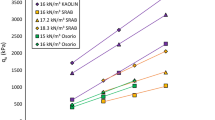Abstract
Recently in China, soil–cement is widely used to improve the soft ground in the highway construction engineering. Literature studies are mainly investigating the mechanical properties of the soil–cement, while its properties of the electrical resistivity are not well addressed. In this paper, the properties of the electrical resistivity of the reconstituted soil-cement and the in situ soil–cement columns are investigated. The test results show that the electrical resistivity of the soil–cement increases with the increase in the cement-mixing ratio and curing time, whereas it decreases with the increase in the water content, degree of saturation and water–cement ratio. A simple equation is proposed to predict the electrical resistivity of soil–cement under the condition of the specified curing time and water–cement ratio. It is found that the electrical resistivity has a good relationship with the unconfined compression strength and blow count of SPT. It is expected that the electrical resistivity method can be widely used for checking/controlling the quality of soil–cement in practice.










Similar content being viewed by others
References
ASTM (2005) Standard test method for measurement of soil resistivity using the two-electrode soil box method (G187–05). American Society for Testing and Materials
Bergado DT, Anderson LR, Miura N, Balasubramaniam AS (1996) Soft ground improvement in lowland and other environments. American Society of Civil Engineers, New York
Chai JC, Liu SY, Du YJ (2002) Field properties and settlement calculation of soil-cement column improved soft subsoil-a case study. Lowland Technol Int 4(2):51–58
Giao PH, Chung SG, Kim DY, Tanaka H (2003) Electric imaging and laboratory resistivity testing for geotechnical investigation of Pusan clay deposits. J Appl Geophys 52(4):157–175
Holm G (1999) Applications of dry mix methods for deep soil stabilization. Paper presented at the international conference on dry mix methods for deep soil stabilization, Stockholm, pp 3–13
Horpibulsuk S, Miura N, Nagaraj TS (2003) Assessment of strength development in cement admixed high water content clays with Abram’s law as a basis. Geotechnique 53(4):439–444
Komine H (1997) Evaluation of chemical grouted soil by electrical resistivity. Ground Improvement 1:101–113
Lorenzo GA, Bergado DT (2004) Fundamental parameters of cement-admixed clay-new approach. J Geotech Geoenviron Eng ASCE 130(10):1042–1050
Liu SY, Hryciw RD (2003) Evaluation and quality control of dry-jet-mixed clay soil–cement columns by standard penetration test. J Transportation Res Board 1849:47–52
McNeill J (1999) Use of electromagnetic methods for groundwater studies. In: Ward SH (ed) Geotechnical and environmental geophysics. Society Of Exploration Geophysicists, pp 191–218
Miao LC, Liu SY, Yan ML (2003) Research on electrical resistivity feature of soil–cement and its application. Rock Soil Mech 20(1):126–130
Seaton WJ, Burbey TJ (2002) Evaluation of two-dimensional resistivity methods in a fractured crystalline-rock terrane. J Appl Geophys 51(1):21–41
Yu XJ (2004) On the theory and application of electrical resistivity method in geotechnial engineering (in Chinese). PhD, Southeast University, Nanjing, China
Ackowledgment
This study is part of the Project titled “On the electrical resistivity characteristics of structural Soils” financially supported by the Natural Science Foundation of China (NSFC) (Grant No. 50478073,2005–2007). The authors highly appreciate Dr. A. Sridharan, Professor Emeritus, Indian Institute of Science, for his comments and discussions during the preparation of this paper.
Author information
Authors and Affiliations
Corresponding author
Rights and permissions
About this article
Cite this article
Liu, S.Y., Du, Y.J., Han, L.H. et al. Experimental study on the electrical resistivity of soil–cement admixtures. Environ Geol 54, 1227–1233 (2008). https://doi.org/10.1007/s00254-007-0905-5
Received:
Accepted:
Published:
Issue Date:
DOI: https://doi.org/10.1007/s00254-007-0905-5




